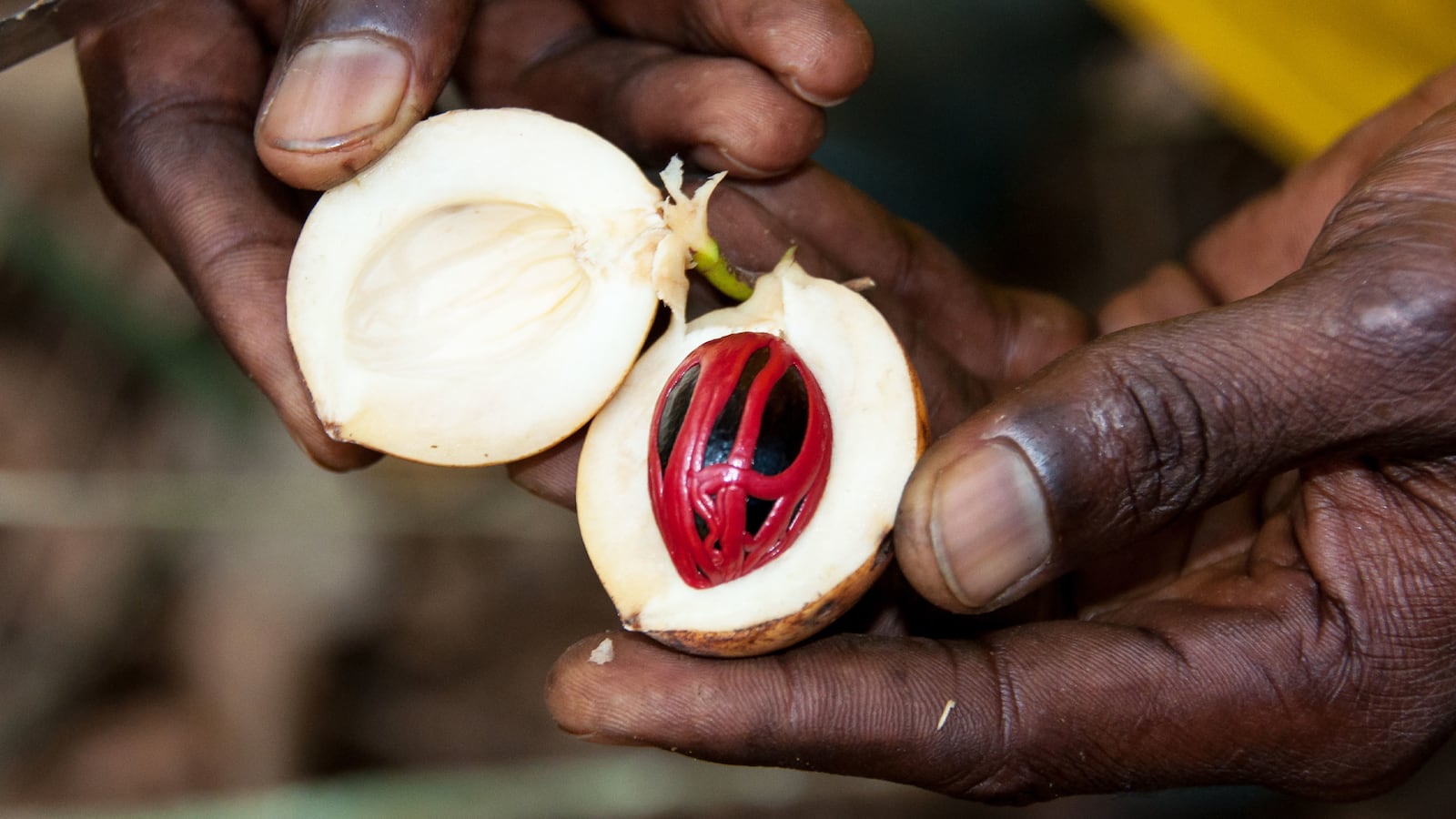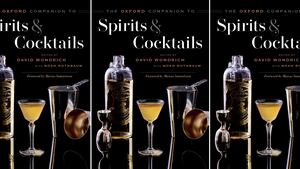In 2013, when Jim Ryan was a brand ambassador with Hendrick’s Gin, he was on a trip to Malaysia when he and his girlfriend (now wife) stopped by a local street market.
“We came across this nutmeg stall, and they were taking fresh nutmeg a bit before it was ready to harvest, then chopping up the whole nutmeg—the fruit, the nut, the seed, the aril.” They fed it all into an extractor, then took the juice and mixed it with some sugar and water, poured it over chipped ice and served it in a plastic bag.
Nothing fancy. “But it bewitched me,” Ryan says, calling it a transformative experience. “It was experiencing the spectrum of nutmeg rather than just a narrow band. It had so much more to offer than what I assumed nutmeg was.”
Fast forward to 2016. Ryan left his Hendrick’s gig with the idea of launching his own business. Inspired by the ancient stalwarts of the liqueur world—Cointreau, Chartreuse, Grand Marnier— his thoughts turned back to his trip to Malaysia, and his astonishment at his first taste of fresh nutmeg. He boarded a plane back to Penang.
Ryan wasn’t the first to be taken with nutmeg. In the 17th century, much of the world seemed utterly smitten with this exotic spice. Wars were fought over control of the nutmeg trade—for decades, the Dutch maintained a monopoly, until they didn’t—and its cultivation expanded globally, with Grenada becoming the nutmeg center of the Western hemisphere. Itinerant nutmeg traders from Connecticut were familiar enough that in the 19th century state residents were called “Nutmeggers.”
Why was nutmeg so prized? The exotic taste was surely part of the appeal—this was the age of gruel, and anything to enhance a meal was welcome. But the rarity drove demand to staggering heights. “People always want what they can’t have,” Ryan says. “Owning a jar of nutmeg was like owning an actual rock from the moon, only it was better because it also tasted great. You were basically saying, ‘Welcome to my newest yacht.’”
I’d wager most of us think of nutmeg as that hard, oval nut the size of a manzanilla olive—a kernel as dense as wood that’s grated into a pale ochre powder. But nutmeg actually has three components: a pear-like fruit, inside which is dense red webbing (the aril) that surrounds the pit. The fruit is usually discarded; the webbing is dried and sold as mace, with a flavor that’s less intense but similar to nutmeg. The “nut” in the middle is sold whole or ground as nutmeg.
Ryan’s original idea was to collect the fruit and ferment it. But early trials were unimpressive; he could only ferment to about two percent alcohol, which meant he’d need massive amounts to produce enough to make a spirit.
Drawing on his knowledge of gin, Ryan opted for a maceration and distillation method to extract the flavor. And he would use all the nutmeg—fruit, mace and pit—to infuse his liqueur and give it an uncommon depth. Mace and nutmeg were widely available through wholesalers, but getting the fruit proved problematic. When he met with “the nutmeg king” of Malaysia to ask about buying his fruit, the man countered by saying, “I want to sell you the empire”—he was more interested in selling his entire business. (Something similar happened in Grenada.)
In Grenada, he found a farmer happy to sell him fruit, but he couldn’t find a processing facility to prepare the fruit for shipment. The fruit of the nutmeg can be difficult to work with—it’s fibrous, like ginger, Ryan says. And it needs to be dried before export.
Back home in Brooklyn he spotted an article about a Queens-based spice importer called Burlap & Barrel, which traveled the world looking for fresh sources. He sent off an email, and co-founder Ethan Frisch wrote back the same day—he’d actually been looking for someone interested in the nutmeg fruit produced at a farm cooperative in Zanzibar, Tanzania, where the company sourced its nutmeg spice. Frisch and his partner Ori Zohar hoped to find a new revenue stream for the cooperative.
Ryan flew to Africa and visited the farm. It had the facilities to chop and dry the fruit and could package it in burlap sacks for shipment to New York. So the farmers harvested 16,500 kilograms of fresh fruit for him, which was cut up into silver-dollar-sized chunks and dried on screens set across sawhorses, yielding 425 kilos of dried fruit. Ryan returned home with plans for the fruit to follow by ship.

“And then everything went upside down,” Ryan says. He returned in February 2020, and the global pandemic hit a few weeks later. Harbors shut down, and his shipment was delayed for months. It finally arrived later that summer.
Next came the process of crafting a liqueur, using the dried fruit from Zanzibar as well as mace and nutmeg imported from Indonesia. He partnered with Matchbook Distilling Co. on Long Island, a new start-up that Ryan admired for their “punk sensibility”—they’d entered the scene aiming to disrupt more staid distilling practices, especially by using overlooked and spent ingredients, and taking novel approaches to fermentation. The distillery was co-founded by Leslie Merinoff who is a direct descendent of famous whiskey distiller Hiram Walker and her father runs one of the largest liquor distributors in America.
After some experimentation, Ryan and the distillers decided on separately macerating the three nutmeg components in vodka and then running the infused alcohols through the still. They let it all rest for ten days before blending the three components together. The mixture rests again and finally it is proofed to 40 percent alcohol. They add 101 grams of sugar per liter, as is traditional (and legally binding) with liqueurs.
The original name for the liqueur—Pearl Street—ran afoul of trademark issues. So Ryan and his wife, Tess Mix, who works on the business side of the Daily Beast, came up with Myris, named after the botanical name for nutmeg (Myristica fragrans). The elixir went into 375ml bottles and appeared in New York bars and liquor stores earlier this year. (Plans call for expanding to full-sized bottles and other markets in time.)
His philosophy? “Grow deep before growing wide.” When it comes to taste, Myris is not bashful—but neither is Chartreuse nor Benedictine. A little goes a long way. Nutmeg has an ethereal flavor, with notes from the heavens combined with those of a damp pine forest. Using fresh nutmeg fruit adds a slightly unexpected note to those familiar with a bit of grated nutmeg atop a drink. “The fruit has this bright component,” says Ryan, who worked for years as a bartender before entering the gin business. “It’s like a lemonized kind of flavor.”
Ryan says bartenders have been intrigued, using it in riffs on classics, including a variation of the Chartreuse Swizzle and also as an added note in Daiquiris. New York’s famed Dead Rabbit used it in their hot chocolate version of an Irish Coffee, and another bar employed it in an Espresso Martini variation.
A handful have tried using it as a base spirit, but generally it’s best deployed a half or three-quarters of an ounce at a time to lend a twist.
“I didn’t want to put something out there just because no one has done this before. I don’t want to be pigeonholed into something bartenders pick up when its pumpkin spice latte season,” Ryan says. “I want to create a legacy, not just something that lasts for my lifetime.”







